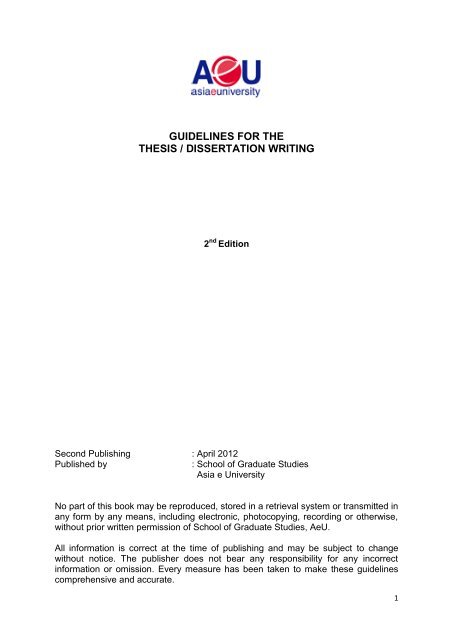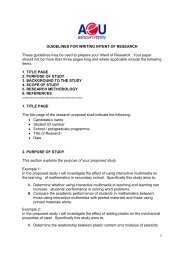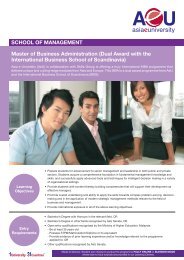GUIDELINES FOR THE THESIS / DISSERTATION WRITING - AeU
GUIDELINES FOR THE THESIS / DISSERTATION WRITING - AeU
GUIDELINES FOR THE THESIS / DISSERTATION WRITING - AeU
- No tags were found...
Create successful ePaper yourself
Turn your PDF publications into a flip-book with our unique Google optimized e-Paper software.
<strong>GUIDELINES</strong> <strong>FOR</strong> <strong>THE</strong><br />
<strong>THE</strong>SIS / <strong>DISSERTATION</strong> <strong>WRITING</strong><br />
2 nd Edition<br />
Second Publishing : April 2012<br />
Published by<br />
: School of Graduate Studies<br />
Asia e University<br />
No part of this book may be reproduced, stored in a retrieval system or transmitted in<br />
any form by any means, including electronic, photocopying, recording or otherwise,<br />
without prior written permission of School of Graduate Studies, <strong>AeU</strong>.<br />
All information is correct at the time of publishing and may be subject to change<br />
without notice. The publisher does not bear any responsibility for any incorrect<br />
information or omission. Every measure has been taken to make these guidelines<br />
comprehensive and accurate.<br />
1
CONTENT<br />
1. INTRODUCTION<br />
2. STRUCTURE OF <strong>THE</strong> POSTGRADUATE PROGRAMME<br />
3. <strong>THE</strong>SIS, <strong>DISSERTATION</strong> AND PROJECT PAPER<br />
4. SUPERVISOR AND SUPERVISION<br />
(1) Supervisor<br />
(2) Additional Requirement for Appointment<br />
(3) Restriction<br />
(4) Change of a Supervisor or Reconstitution of the Supervisory<br />
Committee<br />
(5) Progress Monitoring<br />
5. PROPOSAL DEVELOPMENT AND APPROVAL<br />
(1) Requirement<br />
(2) The Purpose of Research Proposal<br />
(3) Preparation the Research Proposal<br />
(4) Submission Process<br />
(5) Table of Content of Research Proposal<br />
(6) Research Proposal Defense<br />
6. DATA COLLECTION<br />
(1) Permission to Gather Data from Relevant Authorities<br />
(2) Informed Consent and Protection from Harm<br />
(3) Authenticity of Data<br />
7. <strong>WRITING</strong> A <strong>THE</strong>SIS/<strong>DISSERTATION</strong><br />
(1) Introduction<br />
(2) Format of Thesis/Dissertation<br />
1. Cover and Spine<br />
2. Title Page<br />
3. Abstract<br />
4. Signature Approval Page<br />
5. Declaration Page<br />
6. Copyright Page<br />
7. Acknowledgements<br />
8. Table of Contents<br />
9. Lists of Tables<br />
2
10. List of Figures<br />
11. List of Symbols/Abbreviations/Nomenclature/Transliteration<br />
12. Text<br />
13. Appendices/ Supplementaries<br />
14. Citation of Sources<br />
(3) Length of Thesis and Dissertation<br />
(4) Typing<br />
8. PUBLICATION AND AUTHORSHIP<br />
9. SUBMISSION OF <strong>THE</strong>SIS AND <strong>DISSERTATION</strong><br />
10. RESEARCH ETHICS<br />
3
1. INTRODUCTION<br />
These guidelines provide students with essential information about how to<br />
prepare and submit thesis and dissertations in a format acceptable to the<br />
Graduate School at Asia e University. As you begin the process of writing,<br />
you will be carefully documenting the research, theories, methods, results and<br />
conclusion f your efforts. A well-written and well-formatted work will reflect<br />
favourably upon you and Asia e University Graduate School. When<br />
completed, your thesis or dissertation must follow a format and style that are<br />
acceptable, consistent with your field of knowledge.<br />
2. STRUCTURE OF <strong>THE</strong> POSTGRADUATE PROGRAMME<br />
The postgraduate programmes offered by the University are categorised<br />
under three (3) structures as follows;<br />
2.1 Structure I : Degree by Research (e.g.: PhD, MSc)<br />
2.2 Structure II : Degree by Coursework and Research (e.g.: DBA)<br />
2.3 Structure III : Degree by Coursework (e.g.: MBA, MM, MKM, MEd, MICTM)<br />
3. <strong>THE</strong>SIS, <strong>DISSERTATION</strong> AND PROJECT PAPER<br />
A thesis, or a dissertation or a project paper represents the research<br />
component of the postgraduate programme.<br />
At Asia e University, a thesis contributes to 100% fulfilment of the degree<br />
programme through original research under a proper academic supervision<br />
and in a research environment for a prescribed period. In scope, the PhD<br />
thesis differs from a research Master thesis mainly by its deeper and more<br />
comprehensive treatment of its content and subjects. The length of the PhD<br />
thesis varies with each discipline with 80,000 words being the norm. The PhD<br />
thesis should not exceed 100,000 words (excluding appendices) without<br />
special approval of the Dean, School of Graduate Studies. The length of a<br />
master thesis also varies with each discipline should not exceed 80,000<br />
(excluding) without the approval of the Dean, School of Graduate Studies. The<br />
thesis must be defended in an oral examination and/or viva voce examination.<br />
A dissertation or a project paper contributes to a partial fulfilment of the<br />
postgraduate degree by research under a proper academic supervision and in<br />
a research environment for a prescribed period. Without the approval of Dean,<br />
School of Graduate Studies, the length of a doctoral dissertation and master<br />
dissertation should not exceed (excluding appendices) 80,000 and 60,000<br />
4
words respectively. The length of a 3-credit project paper should not exceed<br />
12,000 words (excluding appendices).<br />
The thesis, or dissertation or project paper demonstrates authority in the<br />
candidate’s field and shows evidence of command of knowledge in relevant<br />
fields.<br />
Thesis Dissertation Project Paper<br />
Fulfillment Full Partial Partial<br />
Length (PhD)<br />
< 100 K words<br />
< 80 K words<br />
Business<br />
(Master)<br />
< 80K words<br />
< 60 K words<br />
Administration:<br />
Around 12K words<br />
Education:<br />
Around 6K words<br />
Purpose<br />
Est. time<br />
frame<br />
Demonstrates authority in the candidate’s field and<br />
shows evidence of command of knowledge in relevant<br />
fields<br />
9 semesters 6 semesters 1 – 2<br />
semesters<br />
4. SUPERVISOR AND SUPERVISION<br />
Dissertation / Thesis Supervision for Students under Structure I and II<br />
(1) Advisor<br />
At the initial stage of the candidature, students are assigned an advisor<br />
from the respective school. The advisor role is to guide student in<br />
preparing the Intent of Research in the first semester of candidature.<br />
Intent of Research<br />
Before a supervisor can be appointed, a student needs to submit a 2-<br />
page of Intent of Research to SGS by indicating the following;<br />
5
(i)<br />
(ii)<br />
(iii)<br />
(iv)<br />
proposed title and scope of study,<br />
brief statements of research problems,<br />
conceptual framework (e.g. the variables involved, methods<br />
used in brief)<br />
reasons for undertaking the study (e.g. career enhancement,<br />
academic requirement, self-fulfilment)<br />
(2) Supervisor<br />
The School may assign a suitable supervisor after admission or the<br />
student may nominate his/her own supervisor by submitting a<br />
Nomination of Thesis Supervisor / Supervisory Committee Form (SGS<br />
001) and the research prospectus.<br />
A student with the advice of the Supervisor may nominate a<br />
Supervisory Committee (if required). If a Supervisory Committee is<br />
required, the student must complete and submit a Nomination of Thesis<br />
Supervisor / Supervisory Committee Form (SGS 001) to the School of<br />
Graduate Studies.<br />
A Supervisory Committee must consist of a Chairman and at least one<br />
(1) other member who is capable of providing advice and guidance to<br />
the student’s research.<br />
The Chairman of the Supervisory Committee may be the Supervisor or<br />
any other academic member appointed by the School.<br />
(3) Additional Requirements for Appointment of Supervisor(s)<br />
The nominated Supervisor / Supervisory Committee for Master’s<br />
student may also be one of the following person;<br />
(i)<br />
(ii)<br />
(iii)<br />
An academic staff member who is a Doctoral degree holder; or<br />
An academic staff member with the rank of a Lecturer with a<br />
Master’s degree qualification and has published his research; or<br />
An individual with relevant postgraduate or professional<br />
qualification recognised by the University.<br />
Whereas, Supervisor / Supervisory Committee for a student pursuing a<br />
Doctoral degree may be one of the following person;<br />
6
(i)<br />
(ii)<br />
(iii)<br />
An academic staff member who is a Doctoral degree holder; or<br />
An academic staff member who is a Professor / Associate<br />
Professor; or<br />
An individual with relevant postgraduate or professional<br />
qualification recognised by the University.<br />
(4) Restriction<br />
A Supervisor or members of a Supervisory Committee shall not in any<br />
manner be personally related to the student who is under their<br />
supervision.<br />
(5) Change of a Supervisor or Reconstitution of the Supervisory<br />
Committee<br />
A student may seek the Dean to change the Supervisor or reconstitute<br />
the Supervisory Committee if he/she believes that continued<br />
supervision by the Supervisor/Supervisory Committee will not lead to<br />
the satisfactory completion of the degree.<br />
(6) Progress Monitoring<br />
Student is requested to discuss their research progress with their<br />
supervisor and submit a half-yearly progress report (SGS 002) by the<br />
first week of January and the first week of July. This is a part of<br />
monitoring process and the SGS shall act for improvement based on<br />
the progress analysis report.<br />
5.0 PROPOSAL DEVELOPMENT AND APPROVAL<br />
(1) Requirement<br />
During the Stage 1 of Structure I, the research proposal should be submitted<br />
within the stipulated period from date of registration of the first semester to the<br />
School of Graduate Studies.<br />
For Structure II, a student is required to fulfil a minimum number of credit<br />
hours of coursework and examinations. Subject to the student’s performance<br />
in the coursework component, and the approval of Dean of School of<br />
7
Management, a student is allowed to proceed work on his/her research<br />
proposal.<br />
(2) The Purpose of the Research Proposal<br />
The purpose of this proposal is to clearly set out the following;<br />
(i)<br />
(ii)<br />
(iii)<br />
(iv)<br />
(v)<br />
goals of the research study<br />
relationship of the work to the current body of knowledge in the chosen<br />
discipline area<br />
methodologies by which the goals will be addressed<br />
plausible outcomes of the work, together with their significance, and<br />
candidate’s capabilities in conducting the research together with the<br />
timeline<br />
(3) Preparing the Research Proposal<br />
Candidates should conduct an initial literature search and review the existing<br />
literature concerned with content and methodology. This is the most critical<br />
activity before writing the research proposal. The better that your research is<br />
‘grounded in’ or ‘tied to’ the literature, the greater will be its credibility,<br />
persuasiveness and authority.<br />
Candidates are required to discuss with their supervisor or supervisory<br />
committee member(s) on the focus and purpose of the research proposal as<br />
stipulated above.<br />
A doctoral research proposal should normally be around 10 000 words<br />
excluding appendices and references, whereas a proposal for Master degree<br />
programme (Structures I and II) normally comprises about 8 000 words.<br />
For Structure III, a simple research proposal of about 300 words is required<br />
for Master programme by Coursework. This proposal should include the title,<br />
purpose(s) of research and methodology used.<br />
(4) Table of Content of Research Proposal<br />
The table of content for the research proposal shall consist of the following;<br />
(i)<br />
(ii)<br />
Synopsis<br />
This section is the ‘face’ of your proposal. It is written to give an<br />
overview of the context, purpose, objectives, justifications for research,<br />
expected results and what makes you think that the research will make<br />
a useful contribution to knowledge.<br />
Introduction<br />
(a) Background of study<br />
Should arouse interest and convince the reader that the research<br />
is justifiable and the problem is worth researching.<br />
8
(b)<br />
Problem Statement<br />
This is a statement that clearly defines the ‘problem’ the intended<br />
study is going to answer. It has to be well framed - clear, precise,<br />
specific, measurable and attainable.<br />
(iii)<br />
Research Purpose and Objectives<br />
(a) Research Purpose<br />
This section provides the focus of research. Researcher must<br />
state the purpose of the research, and it must be anyone or a<br />
combination of these – to explain, to explore, to predict or to<br />
describe.<br />
(b)<br />
Research Objectives<br />
The objectives detailed the reasons why the research is being<br />
carried out. It also provides the scope and parameters within which<br />
the study will be conducted. Objectives set must be SMART<br />
(specific, measurable, attainable, realistic and time bound).<br />
(c)<br />
Justifications<br />
If in the ‘Background’ section you provide an ‘overall’ reason why<br />
the research is significant and merits a more detailed<br />
investigation, this section requires you to justify why the research<br />
is necessary in the context of the purpose and objectives you had<br />
stated above.<br />
(iv)<br />
Review of Literature<br />
(a) Issues Addressed<br />
This is the first thing to identify in the literature review where need<br />
to identify areas or issues where they had not ventured into. If you<br />
are interested in an issue but other had done some work on it,<br />
then look for past findings that you can improve on and add new<br />
dimensions.<br />
(b)<br />
(c)<br />
Methods Employed<br />
• Guiding theory(ies) used<br />
• Conceptual frameworks used / approach adopted, variables<br />
used to represent the concepts being studied, scales and<br />
measurement used, how variables are being measured and<br />
major hypothesis being tested<br />
• Data Collection instruments employed<br />
• Respondents used in the study<br />
• Sampling<br />
Major Findings and Research Gaps Identified<br />
(v)<br />
Research Method<br />
(a) Operational definitions of main concepts and variables to be used<br />
(b) Guiding theory(ies) to be used as a basis of informing the<br />
research<br />
9
(c)<br />
(d)<br />
(e)<br />
(f)<br />
(g)<br />
(h)<br />
(i)<br />
(j)<br />
Conceptual frameworks to be used / approach to be adopted<br />
Variables used to represent the concepts being studied.<br />
Scope of the study.<br />
Major hypothesis being tested.<br />
Scales and measurements to be used and how variables are<br />
going to be being measured.<br />
Data Collection instruments to employed and data collection<br />
plans.<br />
Who are the respondents, how they are going to be selected how<br />
sampling is going to be done.<br />
Data analysis – how data is going to be analysed. This includes<br />
what statistical techniques are going to be used for data analysis<br />
and to test the validity and reliability of data and to<br />
explain/interpret the results expected to be obtained.<br />
(vi)<br />
(vii)<br />
Implications and Limitations<br />
This should consist of expected results from your study, its implication<br />
in the context of ‘extending the frontier of knowledge and limitations you<br />
might encounter that will affect your data collection, analysis and<br />
findings.<br />
References<br />
Use the APA format.<br />
(5) Submission Process<br />
After student prepared the proposal with the consultation of the Supervisor(s),<br />
students are require to submits final copy of the proposal to SGS together with<br />
Form SGS 003 and power point slides at least one month before the vetting<br />
process.<br />
(6) Research Proposal Defense<br />
In the proposal defense session, student must formally defend the research<br />
proposal to the Proposal Defense Committee. During the session, the student<br />
need to presents the proposal, including the problem identification,<br />
background literature and rationale for study, hypotheses, procedural details,<br />
analysis plan, and expected limitation. This is the time for dialogue between<br />
the student and the committee in order to clarify any questions, discuss and<br />
negotiate any suggested modification, recommend resources, and provide<br />
support to the research efforts of the student.<br />
SGS tables the appointment of member of Proposal Defense Committee for<br />
approval in Postgraduate Studies Committee (PSC) meeting. The task of the<br />
Proposal Defense Committee member is to attend the Proposal Defense<br />
10
Session, critically review and evaluate the proposal and sign the approved<br />
proposal.<br />
6. DATA COLLECTION<br />
(1) Permission to Gather Data from Relevant Authorities<br />
A candidate is requested to seek the permission from the relevant bodies of<br />
each country that approves the conduct and the ethical considerations of the<br />
research before the candidate is allowed to embark onto the proper data<br />
gathering procedures. The letters of consent from the relevant authorities<br />
must be disclosed to the supervisor(s) and attached in the thesis as<br />
appendix.<br />
(2) Informed Consent and Protection from Harm<br />
Perhaps the most basic and important ethical issues in research are<br />
concerned with participants’ right to informed consent and freedom from harm.<br />
Researchers obtain informed consent by ensuring that research participants<br />
enter the research of their free will and with the understanding of the nature of<br />
the study and any possible dangers that may occur. This requirement is<br />
intended to reduce the likelihood that participants will be exploited by a<br />
researcher persuading them to participate when they are not fully aware of<br />
what the study’s requirements are.<br />
Researchers must ensure freedom from harm by not exposing participants to<br />
undue risks. This requirement includes issues of confidentiality (protecting<br />
participants from ridicule or embarrassment) and issues related to personal<br />
privacy. Collecting information on participants or observing them without their<br />
knowledge or without appropriate permission is considered unethical.<br />
Furthermore, any data or information that are gathered, either from or about a<br />
person, should be strictly confidential. Access to data should also be limited to<br />
persons directly involved in conducting the research.<br />
(3) Authenticity of Data<br />
The researcher must declare that the thesis is his/her own work and that all<br />
contributions from any other persons or sources are properly and duly cited.<br />
The researcher further declares that it does not constitute any previous work<br />
whether published or otherwise. Candidate and supervisor(s) have the<br />
obligation to ensure the authenticity of data.<br />
Data must normally be kept in a safe place with a proper security and for at<br />
least two years. Original data must be made available if requested to show<br />
evidence of authenticity.<br />
11
7. <strong>WRITING</strong> OF <strong>THE</strong>SIS AND <strong>DISSERTATION</strong><br />
(1) Introduction<br />
There are many styles of writing thesis and dissertations. For consistency,<br />
students are encouraged to conform to the format approved by <strong>AeU</strong>.<br />
(2) Format of Thesis/Dissertation<br />
Typically, the format of thesis and dissertation consists of 14 parts as<br />
suggested below.<br />
1) Cover and Spine<br />
2) Title Page<br />
3) Abstract<br />
4) Signature Approval Page<br />
5) Declaration Page<br />
6) Copyright Page<br />
7) Acknowledgements<br />
8) Table of Contents<br />
9) Lists of Tables<br />
10) List of Figures<br />
11) List of Symbols/Abbreviations/Nomenclature/Transliteration<br />
12) Text<br />
13) Appendices/Supplementaries<br />
14) Citation of Sources<br />
Preliminary Pages: Overview<br />
(Cover and Spine, Title page, Copyright page, Signature Approval<br />
Page, Declaration, Acknowledgement, Abstract, Table of Content,<br />
List of Figures and List of Tables)<br />
1) Cover and Spine (Refer to Sample A)<br />
The final copy of the thesis/dissertation must be hardbound in black<br />
with gold letterings.<br />
As for the cover, the title of the thesis/dissertation, author’s name,<br />
name of institution (ASIA e UNIVERSITY), and year of submission<br />
must be printed in uppercase with font size of 14 pitch in Arial, and<br />
centrally alignment. The words in title must be arranged in the<br />
inverted pyramid shape.<br />
As for the spine, the title of the thesis/dissertation, author’s name, the<br />
Degree for which the thesis is submitted, and year in uppercase to be<br />
printed on the spine.<br />
12
If the title of the thesis cannot fit the space in the spine, smaller font is<br />
allowable.<br />
2) Title Page (Refer to Sample B)<br />
Title page should include the following:<br />
a. Full title of thesis (in uppercase)<br />
b. Full name of author (in uppercase)<br />
c. Degree for which the thesis is submitted<br />
d. Name of the institution to which the thesis is submitted<br />
e. Month and year of submission<br />
The rules for capitalisation in the document title are strict. The first,<br />
last, all principal words and words with 4 letters or more must be<br />
capitalised, including those that follow hyphens in compound terms.<br />
The only words that should not be capitalised are articles (a, an, the),<br />
prepositions (e.g., in, to), and conjunctions (e.g., and, but, for).<br />
3) Abstract<br />
For the doctoral dissertation, an abstract not exceeding 350 words or<br />
2,450 characters is to be included--approximately one and one-half<br />
pages doubled-spaced.<br />
The abstract should state the research problem in brief, describe the<br />
methods and procedures used in gathering data or studying, the<br />
problem, and provide a condensed summary of the findings of the<br />
study.<br />
If the thesis is written in another language, the abstract in that<br />
language must be translated into English language. The English<br />
version must appear in a separate page.<br />
4) Signature Approval Page (Refer to Sample C)<br />
A separate page containing the name of author, title and the<br />
signatures of the committee members with their designations. Only<br />
persons who has been assigned by the Examination Committee to<br />
confirm the corrections to be made to the thesis shall sign this<br />
approval page.<br />
5) Declaration Page (refer to Sample D)<br />
Numbered as usual<br />
13
6) Copyright Page (Refer to Sample E)<br />
Centred at the bottom, no heading, counted but unnumbered.<br />
7) Acknowledgement<br />
Usually contain written expressions of appreciation for guidance and<br />
assistance from individuals or/and institutions. The<br />
acknowledgements should not exceed 250 words.<br />
8) Table of content<br />
Each thesis or dissertation is expected to have a table of contents for<br />
the convenience of the reader.<br />
The table of contents should be easy to read and consistent. The title<br />
of each chapter should be written in full capital with no terminal<br />
punctuation.<br />
The title of a subdivision of a chapter or section should be in small<br />
letters, with the exception of the first letter of significant words.<br />
9) List of Tables<br />
The list of tables follows the table of contents. This list includes the<br />
number of each table, the title and the page number.<br />
10) List of Figures<br />
The list of figures follows the list of tables. This list includes the<br />
number of each figure, the title and the page number.<br />
11) List of Symbols/Abbreviations/Nomenclature/Transliteration<br />
The list of symbols/abbreviations/nomenclature/transliteration follows<br />
the list of tables. This list includes the number of each figure, the title<br />
and the page number.<br />
12) Text<br />
There is no specific format for the text. Candidates and supervisors<br />
should ensure that the text follows the agreed conventions of the<br />
individual School.<br />
Normally, the text consists of the following chapters;<br />
1) Introduction<br />
2) Review of Literature<br />
3) Methodology<br />
4) Findings<br />
5) Summary, Conclusion and Implications<br />
14
i. Spacing<br />
All text must be double- spaced and justified. Each paragraph should<br />
be indented. The double-spacing is even throughout. There should<br />
not be any “quadruple” spaces.<br />
ii. Font Size and Typeface<br />
Font size should be 12 pitch for the texts. However, font size of 10<br />
pitch is allowable in tables. Italic print should not be used except for<br />
emphasis (e.g. foreign words other than the language used in the<br />
thesis). The same typeface must be used throughout the manuscript,<br />
including the page numbers, footnotes and/or endnotes. The entire<br />
text of the thesis, including headings and page numbers, must be<br />
printed using Times New Roman.<br />
iii. Margin<br />
For binding purposes, the left margin should be at least 4cm (1.5<br />
inches) and the right, top and bottom margins should be at least<br />
2.5cm (1 inch). All information (text, headings, footnotes and<br />
figures), including page number, must be within the text area.<br />
iv. Page Numbering<br />
All page numbers should be printed 1.0 cm from the bottom margin<br />
and placed at the right hand side without any punctuation. Roman<br />
numerals (1, ii, iii, etc.) should be used in the preface section.<br />
Although the Title Page is the first page of the Preface, no number is<br />
printed on it. Numbering begins on the second page with (ii). Arabic<br />
numerals (1, 2, 3) are used on the pages of the text and<br />
supplementary sections.<br />
13. Appendices/ Supplementaries<br />
Specific items which were not included in the main body of the text should<br />
be put in the Appendix /Supplementary Section. Typically, this section may<br />
include the following items:<br />
1) Research instruments such as questionnaires, maps, interview<br />
protocols, or tests<br />
2) Figures<br />
3) Equations<br />
4) Chapter Layout<br />
5) Tables<br />
6) Footnotes<br />
7) Other relevant information<br />
8) Selected bibliography or references<br />
15
14. Citation of Sources<br />
Sources are normally cited in footnotes, figures, tables and bibliography or<br />
references. Reference citations based on the editorial styles of the<br />
American Psychological Association (APA).<br />
(3) Length of Thesis and Dissertation<br />
The length of thesis/dissertation should not exceed the stipulated number<br />
of words (excluding footnotes, appendices, tables and prefaces) as<br />
regulated by the University Senate.<br />
Thesis for PhDs<br />
: 100,000 words<br />
Dissertation for Doctorates<br />
: 80, 000 words<br />
Thesis for Masters<br />
: 80, 000 words<br />
Dissertation for Masters<br />
: 60,000 words<br />
Project Paper for Masters<br />
For School of Management<br />
: 12,000 words<br />
For School of Education : 6,000 words<br />
(4) Typing<br />
All typing must be double spacing between lines. However, in citing<br />
references and quotations, single spacing is recommended.<br />
16
<strong>THE</strong> PhD SUPERVISORY RELATIONASHIP<br />
AND PROCESS IN OPEN AND DISTANCE ZALEHA BINTI ISHAK PhD<br />
LEARNING INSTITUTIONS 2010<br />
Sample A: Example of Cover Page and Spine<br />
<strong>THE</strong> PhD SUPERVISORY RELATIONSHIP AND PROCESS IN<br />
OPEN AND DISTANCE<br />
LEARNING INSTITUTIONS<br />
ZALEHA BINTI ISHAK<br />
ASIA e UNIVERSITY<br />
2010<br />
17
Sample B: Example of Title Page<br />
<strong>THE</strong> PhD SUPERVISORY RELATIONSHIP AND<br />
PROCESS IN OPEN AND DISTANCE<br />
LEARNING INSTITUTIONS<br />
ZALEHA BINTI ISHAK<br />
A Thesis Submitted to the School of Education,<br />
Asia e University in Fulfilment of the<br />
Requirements for the Degree of<br />
Doctor of Philosophy<br />
in Education<br />
February 2010<br />
18
Sample C: Example of Approval Page<br />
APPROVAL PAGE<br />
I certify that I have supervised / read this study and that in my opinion it conforms to<br />
acceptable standards of scholarly presentation and is fully adequate, in quality and<br />
scope, as a thesis for the fulfilment of the requirements for the degree of Doctor of<br />
Philosophy.<br />
.............................................. ...........................................<br />
Dr Abdullah Husein<br />
Supervisor<br />
Professor Abu Bakar Othman<br />
Co-supervisor<br />
.............................................. ...........................................<br />
Professor Alan Baker<br />
Dr Hassan Ibrahim<br />
External Examiner 1 External Examiner 2<br />
.............................................. ...........................................<br />
Professor K. Palanasamy<br />
Internal Examiner 1<br />
Professor Siow Heng Loke<br />
Chairman, Examination Committee<br />
This thesis was submitted to the School of Education, Asia e University and is<br />
accepted as fulfilment of the requirements for the degree of Doctor of Philosophy.<br />
.............................................. ...........................................<br />
Professor John Arul Phillips<br />
Dean, School of Education<br />
Professor Siow Heng Loke<br />
Dean, School of Graduate Studies<br />
19
Sample D: Example of Declaration<br />
Declaration<br />
I hereby declare that the thesis is submitted in fulfilment of the PhD<br />
degree is my own work and that all contributions from any other persons<br />
or sources are properly and duly cited. I further declare that the material<br />
has not been submitted either in whole or in part, for a degree at this or<br />
any other university. In making this declaration, I understand and<br />
acknowledge any breaches in this declaration constitute academic<br />
misconduct, which may result in my expulsion from the programme<br />
and/or exclusion from the award of the degree.<br />
Name: Zaleha binti Ishak<br />
Signature of Candidate: Date: 1 January 2010<br />
20
Sample E: Copyright Page<br />
Copyright by Zaleha binti Ishak and Asia e University<br />
21
8.0 PUBLICATION AND AUTHORSHIP<br />
(1) Publication<br />
A student may choose to submit parts or the entire thesis as a series of<br />
related papers, or manuscripts intended for publication. This requires prior<br />
consent of the supervisor/supervisory committee and appropriate copyright<br />
permission. The paper(s) will normally form one or more well defined thesis<br />
chapters; details of organization and content are determined by the student<br />
and the supervisory committee. The publication status (submitted, in revision,<br />
in press, or published, with dates) and book or journal details (volume, page<br />
numbers, etc.) of any manuscripts or papers included in the thesis must be<br />
specified with each such chapter.<br />
(2) Authorship<br />
Single or multiple names of authorship is permissible in the publication,<br />
provided that the student has made a substantial contribution to the work.<br />
Academic unit guidelines may specify the number and/or order of authors in<br />
accordance with discipline practice. The student's contribution to both the<br />
research and the writing of any multi-authored paper must be clearly specified<br />
either in the introduction to the thesis or at the beginning of each relevant<br />
chapter.<br />
9.0 SUBMISSION OF <strong>THE</strong>SIS AND <strong>DISSERTATION</strong><br />
A candidate is required to submit the notice of submission of research report /<br />
dissertation / thesis to the Dean or Director at least three (3) months before<br />
the actual date of submission by using Form SGS 006.<br />
The submission has to be completed during the term of candidature. The<br />
candidate should lodge six copies of it. At this stage, six copies of the<br />
research report can be submitted in loose binding for internal examination. As<br />
for the dissertation or thesis, one copy is to be firmly bound in cloth with stiff<br />
boards for the external examiner while the remaining five copies are in loose<br />
binding. When the research report / dissertation or thesis has been passed by<br />
the examiners, all copies submitted are to be firmly bound.<br />
10.0 RESEARCH ETHICS<br />
Research Ethics involves all the moral and professional issues relating to<br />
research. The most serious breach of ethical standards in writing research<br />
report / dissertation / thesis is the offence of plagiarism: the expropriation of<br />
then intellectual property of another. Plagiarism is defined as the use of<br />
22
original work, ideas or actual texts created by others, without acknowledging<br />
the original source. Such acknowledgement should be made by:<br />
The use of ideas or words of others must be acknowledged individually in the<br />
text. In addition, each of the work consulted has to be included in the<br />
‘references’ or selected bibliography.<br />
If the quoted citation contains more than four sentences, it should be placed<br />
within a paragraph of its own with a 1 cm indentation. For example:<br />
The general theory of relativity, on its own, cannot explain these features or<br />
answer these questions because of its prediction that the universe started off<br />
with infinite density at the big bang singularity. At the singularity, general<br />
relativity and all other physical laws break down: one couldn't predict what will<br />
come out of the singularity (Hawking, 1988:122).<br />
If only part of the quotation is cited, the citation should be marked with an<br />
ellipsis (…), for example:<br />
There must be give and take, with the teacher being a participant as well as<br />
leader and.., a source of answers' (Sizer, 7984:9).<br />
23








